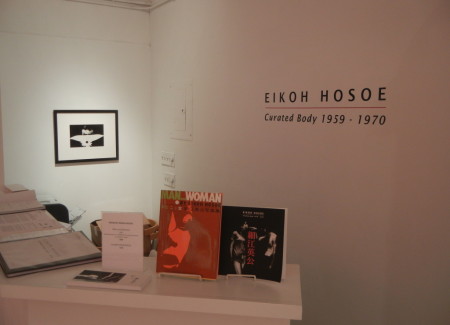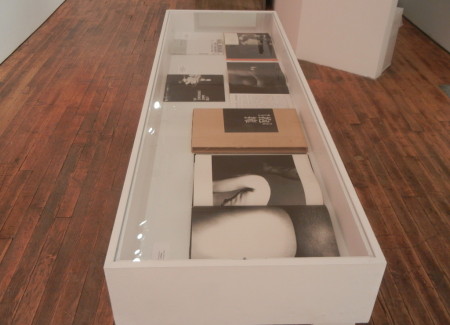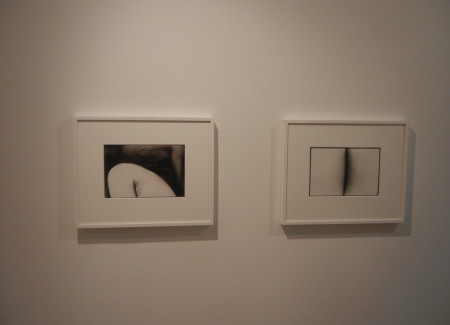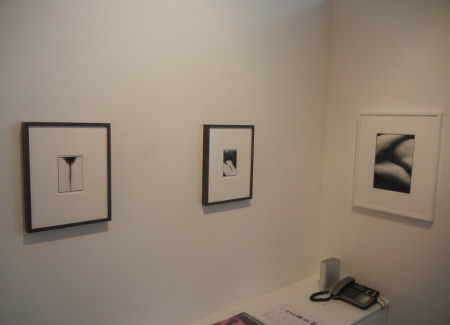JTF (just the facts): A total of 34 black and white photographs, hung against white and red striped walls in the main gallery space, the smaller back room, and the office area. 13 of the works are from the Man and Woman series, made between 1959 and 1960. All of these prints are vintage gelatin silver prints, framed in black and matted, and sized roughly 8×12 (or reverse) or 10×10. The other 21 works are from the Embrace series, made between 1969 and 1970. All of these prints are vintage gelatin silver prints, framed in white and matted, and sized between roughly 3×5 and 8×12 (or reverse).The show also includes a glass case with examples of vintage photobooks from both series. A small catalog of the exhibit (with essays by Lesley Martin and Yayoi Shionoiri) is available from the gallery. (Installation shots below.)
Comments/Context: It’s been quite a few years since two of Eikoh Hosoe’s classic photographic projects from the 1960s and 1970s (Man and Woman and Embrace) have been shown in New York, but that quiet interval has done nothing to diminish their durable power and originality. Taken a decade apart (and bookending two other astonishing projects, Barakei/Ordeal by Roses and Kamaitachi), the two bodies of work both revolve around the male/female relationship and the formal qualities of gestures and body parts. But the pairing is a smart one, as it highlights the nuanced differences in tone and approach between the two sets of iconic images.
Man and Woman uses Tatsumi Hijikata, the founder of Ankoku Butoh (Dance of Darkness), and his other dancers as the centerpiece of Hosoe’s imaginative performances. Emerging from deep black darkness and seen in gritty high contrast whiteness, each pairing of male and female is theatrically metaphorical and filled full with heightened psychological and sexual tension. A woman’s head is carried under a muscular arm, an apple is offered to a nude torso, a finger is pointed, fists line up, nipples touch, and smoky eyes peer out from the obscurity. Even now, these nudes have a sense of brash, radical confrontation, of life being played out in surreal, stylized moments, where an octopus or a kiss might creep out of the shadows.
A decade later, Hosoe would return to the studio, making his Embrace nudes in an intense burst of creativity. In these works, the heads and allegorical props have been removed and Hosoe has moved in closer to explore the contoured abstractions of intertwined human bodies. Light and dark are now opposing contrasts of flesh, with much more tonal subtlety in between; soft white females mix with dark muscular males, the curve of a knee echoed by the arch of a back or a pulsing veined arm encircling a smooth delicate waist. Pressed against each other, the bodies seem to find gentle equilibrium, coming together rather than struggling to set themselves apart. In many cases, masculine and feminine are interlocked so thoroughly that the graceful body parts are hard to identify and the outlines and shadows of the flesh become entirely sculptural.
Seen together, the two projects seem like two sides of the same coin, the bold paired with the tender to find balance. But even in their most ethereal and subdued, Hosoe’s nudes are vital and lively. I think it is this passion (whether overt or internalized) that has helped these photographs remain fresh and challenging; even forty years later, both Man and Woman and Embrace still have the power to nudge us beyond our comfort zone.
Collector’s POV: The works in this show are priced as follows. The prints from Man and Woman range from $10000 to $20000, while the prints from Embrace range from $7500 to $18000. The artist is represented in New York by Howard Greenberg Gallery (here). Hosoe’s work is intermittently available in the secondary markets, often at reasonable prices. In the past several years, his prints and rare photobooks have ranged between $1000 to $9000.













